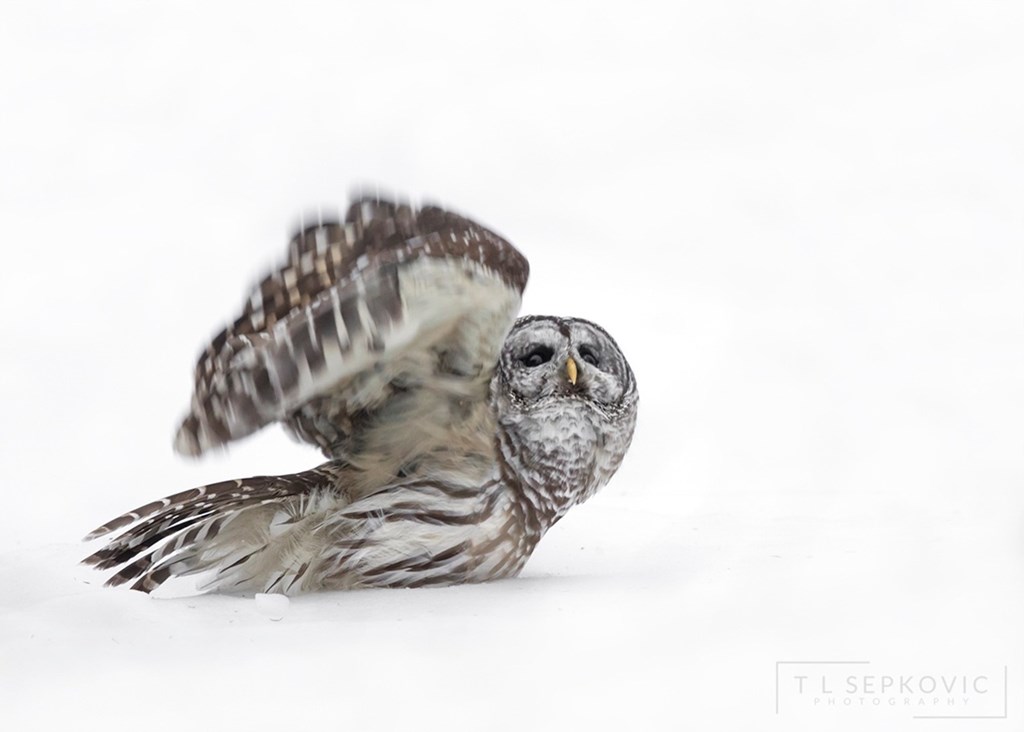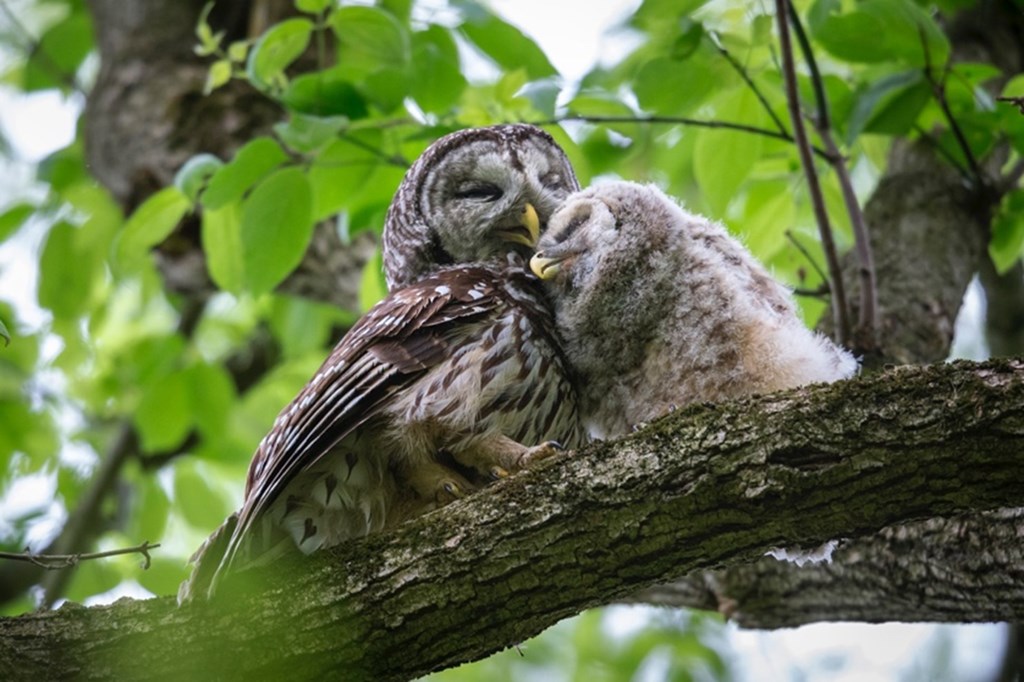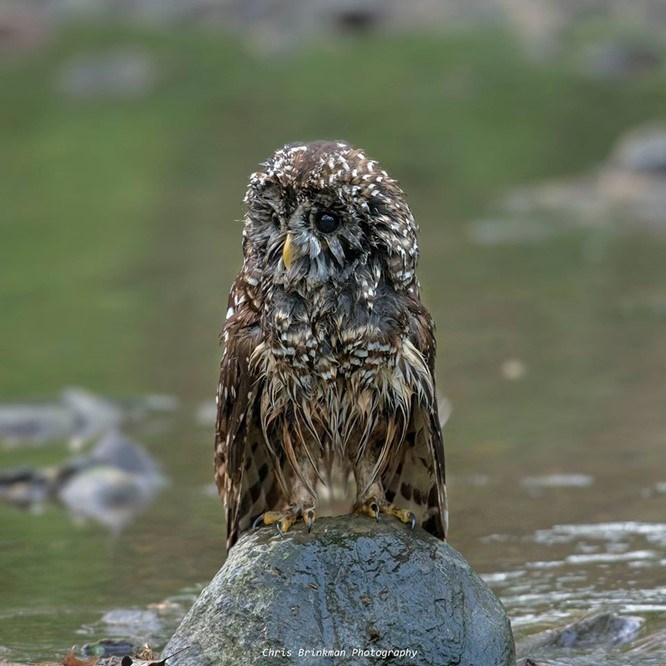Barred Owl
Strix varia

Name
The genus name Strix comes from the Greek word strigx, which, depending on source, refers to “a screech owl,” as well as witches thought to turn to birds at night. Varia refers to the barred plumage of the barred owl, stemming from the word “variegated.”
General Description
The barred owl is a relatively large owl with characteristic horizontal barring on their throat and upper chest, contrasted with vertical streaking in the front. Their backs are dark brown with white spots. They have dark brown eyes, a yellowish-green beak, and a round, tuftless head. Males and females look the same.
Similar Species: In the East, there are no obvious look-alikes to the barred owl. The spotted owl (Strix accidentalis) exists only in the west, and while similar in appearance to the barred owl, is smaller, darker, and more heavily spotted.
Fun Facts
• The oldest individual on record in the wild was at least 24 years old.
• Barred owls have a very diverse diet – a single study of barred owls from western Oregon uncovered 95 different prey items in their diet including 33 mammal species, 25 birds, 3 reptiles, 4 amphibians, 12 insects and 3 snails.
• There are four subspecies of barred owls, with the Pennsylvanian subspecies (S. v. varia) being the most widespread. Central Mexico is home to one subspecies (S. v. sartorii), and the southern United States to two (S. v. helveola and S. v. georgica).
Young barred owls can walk themselves up the trunk of a tree.
• Barred owls are highly active during twilight (making them a “crepuscular” predator) and are more likely to be seen during the day than owls with strictly nocturnal habits.
Barred owls began expanding their range west of the Mississippi at the turn of the 20th century, reaching the Pacific Northwest in 1960.
• Barred owls are often mobbed by smaller birds, verifying that songbirds make up a portion of their diet.
Size
| Females | Males | |
| Wingspan | 108-112cm (42.5-44 in.) ✏️✏️✏️✏️✏️✏️ 6 pencils end to end | About the same |
| Mass | 0.9 kg (nearly 2 lbs) 🍋🍋🍋🍋🍋🍋🍋🍋 8 lemons | 0.5 kg (1.3 lbs) 🍋🍋🍋🍋🍋 5 lemons |
Vocals
The barred owls most commonly recognized vocalization sounds like “Who cooks for you, who cooks for you allll?” However, the repertoire of a barred owl is much more extensive than this one mnemonic; they have 13 recognized vocalizations, and mated pairs will sometimes engage in “gurgle” duets that sound remarkable similar to a perturbed monkey or the evil laugh of a Hollywood villain. Individual barred owls have unique vocals, and like other owls, their vocalizations serve a wide array of communication functions such as territorial defense, food begging, and contact calls that alert mates to each other’s location. Females have a higher pitch than males.
Habitat
Barred owls are capable of residing within a variety of habitats, though their preferred tree composition is a mixture of conifers and hardwoods. They are cavity-dependent, so large old trees are an important habitat feature. Some barred owls avoid human habitation, while other don’t mind the suburban ecosystem if there is a combination of mature trees and open ground interspersed. Given the relatively large size of barred owls, open space is necessary for successful maneuvering while hunting.
Although there is a great deal of debate about the reasons for the barred owl’s recent expansion west, the fact remains that they are now a prevalent species within western forests, especially within the Pacific Northwest.

Feeding
Barred owls are generalist predators. They feed primarily on mammals (rats, shrews, and voles to name a few), but will also consume other birds, reptiles, amphibians, crustaceans, and even fish and earthworms. In the Pacific Northwest flying squirrels make up a large portion of barred owl prey, while in urban North Carolina birds made up 50% of barred owl diets. This goes to show the incredible variety of barred owl feeding habits across their geographical range. When hunting, barred owls often scan from a perch but they are notably agile and can take other birds in flight, including smaller owls.
Nesting
Barred owls nest in cavities, but they are too large to take up residence in the woodpecker holes that smaller owls depend upon. Instead, they utilize stick nests of raptors and crows, as well as tree cavities formed from rot. Occasionally barred owls that cannot find nest sites will force out already-established occupants such as red-shouldered hawks. Choice nesting trees with big enough natural cavities include yellow birch, balsam poplars and sycamores. Barred owls exhibit strong site fidelity, meaning they return to the same sight each year if conditions and resources resulted in successful reproduction. Some of these sites have been occupied by barred owls for over 30 years.
Clutch size is usually 2-3 eggs. The female incubates on her own for 28-33 days. Nestlings begin testing their hopping skills on branches near the nest (called “branching”) at about 4 to 5 weeks of age. Flight occurs at 10 weeks of age. While the young are thought to remain near the adults for some time after fledging, not much is known about family associations during the post-nesting period.
Migration
Barred owls are primarily residential (non-migratory) throughout their range. However, some northern populations may relocate during especially harsh winters, and movement between altitudinal gradients may also occur in the west.

Current Conservation Status
Barred owls have doubled their range in the last century and are currently doing well. In the east, forest maturation is aiding the barred owl by providing more suitable habitat. Given the barred owl’s relative nonchalance about human disturbance, suburban areas provide necessary resources, and therefore allow barred owls to thrive where more disturbance-sensitive owls cannot. It is likely that this species will continue to expand its range, potentially occupying most of North America in the future.
Logging of large old trees in the northern parts of the barred owl’s range could pose a threat, given that in these areas of reduced habitat availability great-horned owls can out-compete them. Rodenticides pose a threat to all mammal-eating raptors, and with the growing presence of barred owls in suburban areas, rodenticides could become a larger issue. West-Nile virus does not appear to affect barred owls as severely as other owls.
How can you help barn owls?
Hawk Mountain’s founder Rosalie Edge emphasized the importance of protecting a species while it is still common. From the standpoint of proactive conservation, it is thus important for us to recognize the beauty and value of barred owls even though they are not currently threatened. By sharing enthusiasm about these backyard owls, we can cultivate a culture of appreciation for a species that we have the privilege of encountering on a regular basis. Alerting your friends and neighbors to the role that barred owls have in controlling rodent populations may help spread awareness about the importance of protecting our shared ecosystems. Encouraging alternatives to rodenticide also positively impacts these charismatic owls.
You can build a nest box to attract a barred owl pair to your own backyard! For more information and instructions on how to erect a nestbox click here, or to support research on barred owls, email Senior Scientist Dr. JF Therrien at [email protected] and/or visit this website.
Special thanks to Chris Brinkman and Traci Sepkovic for their generous photo contributions to this account.
Information written and compiled by Zoey Greenberg.
Sources
Cornell Lab of Ornithology. (2019). All About Birds: Barred Owl. Retrieved from https://www.allaboutbirds.org/guide/Barred_Owl/overview
Johnsgard, P. A. (1988). North American owls: biology and natural history. Washington, D.C.: Smithsonian Institution Press.
Oregon Fish & Wildlife Office. (2013). Barred Owl. Retrieved from
https://www.fws.gov/oregonfwo/Species/Data/NorthernSpottedOwl/BarredOwl/Documents/FAQ.Printable.pdf
Weidensaul, Scott. (2015). Owls of North America and the Carribean. New York: NY.: Peterson Field Guides.